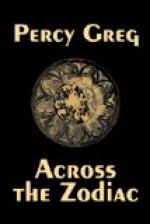a narrow band of brightest green, visible in a gleam
too faint to show any object of a deeper shade.
Somewhat impatient of the obvious symbolism, I hurried
Eveena forward. Immediately on the other side
of the bridge the path turned almost at right angles;
and here a gleam of light ahead afforded a distinct
guidance to our steps. Approaching it, we were
challenged, and I gave the answer with which I had
been previously furnished; an answer which may not
be, as it never has been, written down. A door
parted and admitted us into a small vestibule, at
the other end of which a full and bright light streamed
through a portal of translucent crystal. A sentinel,
armed only with the antiquated spear which may have
been held by his first predecessor in office ten thousand
Martial years ago, now demanded our names. Mine
he simply repeated, but as I gave that of Eveena, daughter
of Esmo, he lowered his weapon in the salute still
traditional among Martial sentries; and bending his
head, touched with his lips the long sleeve of the
cloak of therne-down in which she was on this
occasion again enveloped. This homage appeared
to surprise her almost as much as myself, but we had
no leisure for observation or inquiry. From behind
the crystal door another challenge was uttered.
To this it was the sentry’s part to reply, and
as he answered the door parted; that at the other
end of the vestibule having, I observed, closed as
we entered, and so closed that its position was undiscoverable.
Before us opened a hall of considerable size, consisting
of three distinct vaults, defined by two rows of pillars,
slender shafts resembling tall branchless trees, the
capital of each being formed by a branching head like
that of the palm. The trunks were covered with
golden scales; the fern-like foliage at the summit
was of a bright sparkling emerald. It was evident
to my observation that the entire hall had been excavated
from solid rock, and the pillars left in their places.
Each of the side aisles, if I may so call them, was
occupied by four rows of seats similarly carved in
the natural stone; but lined after Martial fashion,
with cushions embroidered in feathers and metals, and
covered by woven fabrics finer than any known to the
looms of Lyons or Cashmere. About two-thirds
of the seats were occupied; those to the right as
we entered (that is, on the left of the dais at the
end of the hall) by men, those opposite by women.
All, I observed, rose for a moment as Eveena’s
name was announced, from the further end of the hall,
by the foremost of three or four persons vested in
silver, with belts of the crimson metal which plays
the part of our best-tempered steel, and bearing in
their hands wands of a rose-coloured jewel resembling
a clouded onyx in all but the hue. Each of them
wore over his dress a band or sash of gold, fastened
on the left shoulder and descending to the belt on
the right, much resembling the ribbons of European
knighthood. These supported on the left breast




